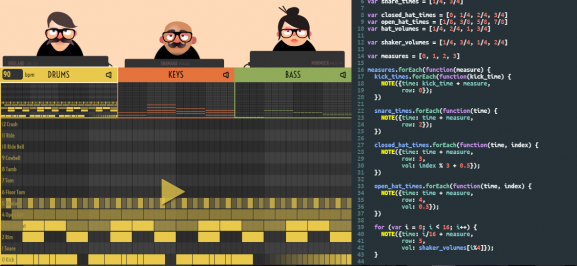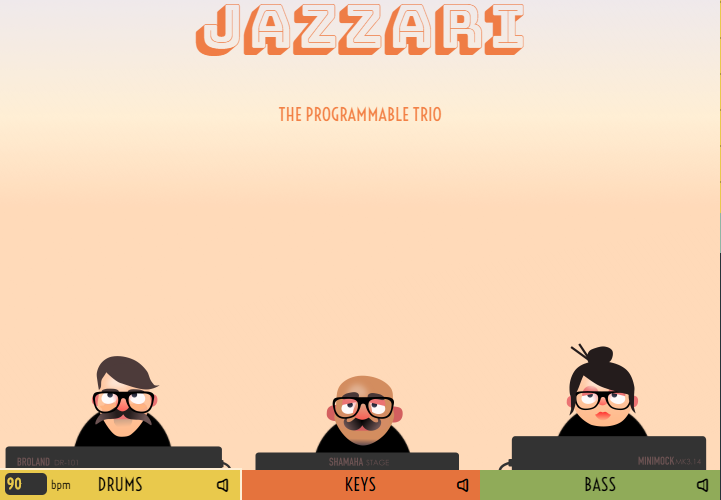Learn to code music in your web browser by controlling this jazz trio
Have you ever looked at music programming and thought “Nope, that’s far too hard. Goodbye”. Well this new site is here to introduce music coding in a fun and easy way.
Jazzari is a free website that guides you through the basics of programming music with a jazz trio under your control. With a simple layout, groovy sounds and a gorgeous interface Jazzari will have you programming an experimental piece of breakbeat techno with Aphex Twin in no time.
The free site opens up presenting you with 3 spectacled, animated musicians with their notes across 4 bars shown below them. To the right you have your sidebar where you scroll through tutorials, examples and write in your code. At first it can seem extremely intimidating, but start with lesson 1 and in no time you’ll start to understand how simple coding with music can be.
A set arrangement will be created automatically for you which you can edit or delete entirely to create your own loop. With 16 beats to each bar, and 4 bars, you can programme in your drums, keys and bass to create a jazzy rhythm and play around with the different elements of music code. You can even download it as MIDI to use in your DAWs or other software.
Tutorials range all the way from how to input your first note, to changing the volume and length of every hit, randomising certain notes, and even using trigonometry in the advanced stages. It’s easy to find the process overwhelming but by following the guides step to step Jazzari provides potentially the most accessible platform for starting music programming.

With a visual layout showing you the timing and notes it’s easy to get tempted to just drag and click your ideas out. Fortunately, Jazzari doesn’t make that possible so you’re forced to create via code. It’s annoying at first but if you’re looking for that experience you can use any of the hundreds of programs that are capable of notation and playback already.
My personal experience, as someone who has never attempted any music programming before, was that this is a fantastic program. Within 10 minutes I had gone from no idea what I was doing, to creating a disjointed yet funky drum pattern. It’s simple enough to breed creativity whilst maintaining the core factors that you need to know when coding music.
Jazzari gets it’s name from the 12th century scholar and inventor Ismail al-Jazari. al-Jazari is said to have invented one of the first ever programmable musical machines. His invention was a “musical automaton, which was a boat with four automatic musicians that floated on a lake to entertain guests at royal drinking parties.”
The creator says that whilst Jazzari may have educational benefits it isn’t meant to actually teach programming or music theory (though it’s a pretty cool introduction). The creator says:
Not really. While I find it conceivable that a motivated reader might be able to learn a bit about loops, variables, scales, or rhythms while using JAZZARI, I don’t think that JAZZARI is a particularly good tool for learning about programming or music. Bret Victor has persuasively argued in Learnable Programming, that making conventional programming environments superficially friendlier, “adorning a JavaScript editor with badges and mascots” does little to support novice programmers. If people manage to learn a bit about quarter notes or JavaScript while using JAZZARI, it will be because they are motivated and patient, not because JAZZARI is well designed for educational purposes. There might be the slightest twinkle of a constructionist sandbox here, but even saying that is slightly disingenuous.
If you’re interested in environments that have been designed specifically to teach programming, check out LOGO or Scratch. Sam Aaron’s Sonic Pi is designed to teach programming through music composition. Ear Sketch is another.
If you’re interested in interactive music tutorials, I recommend Ableton’s Learning Music, NYU’s musedlab, and Funklet.
